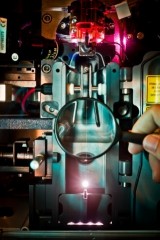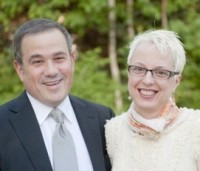 No one would choose the way Glen Jusczyk and Greg Kelly became friends: at the bedsides of their little girls with cancer. Yet these extraordinary circumstances created not just a friendship, but a desire to give back to the place providing their children’s care.
No one would choose the way Glen Jusczyk and Greg Kelly became friends: at the bedsides of their little girls with cancer. Yet these extraordinary circumstances created not just a friendship, but a desire to give back to the place providing their children’s care.
On April 16, these dads, who consider themselves “out of shape,” will run the 116th Boston Marathon® as two of more than 550 runners on the Dana-Farber Marathon Challenge team to raise money for the Claudia Adams Barr Program in Innovative Basic Cancer Research at Dana-Farber.
Jusczyk’s daughter, Malia, was diagnosed with neuroblastoma, a cancer that forms in nerve tissue and mostly affects young children, when she was just 2 years old. The family moved from Orlando, Florida, to Boston shortly after the news so she could be treated in the Neuroblastoma Program at Dana-Farber/Boston Children’s Cancer and Blood Disorders Center, which provides research and the latest treatments.
“We packed our bags as soon as we could,” recalls Jusczyk. “We have family in the Boston area and we wanted Malia to be at the best cancer center in the world for her disease.” There, Jusczyk met Kelly, whose 5-year-old daughter, Charlotte, was across the hall fighting the same type of cancer.

 By Sara Dickison Taylor
By Sara Dickison Taylor Mattel Inc., maker of Barbie dolls, last week announced that it would create a bald version of the popular fashion doll to support people battling cancer.
Mattel Inc., maker of Barbie dolls, last week announced that it would create a bald version of the popular fashion doll to support people battling cancer. At age 7, Sophie was treated for a brain tumor at Dana-Farber/Children’s Hospital Cancer Center. As a result of her treatment, she struggled with ongoing fatigue, weakness on her right side, and chronic headaches.
At age 7, Sophie was treated for a brain tumor at Dana-Farber/Children’s Hospital Cancer Center. As a result of her treatment, she struggled with ongoing fatigue, weakness on her right side, and chronic headaches. At many supermarkets, you can dump a pocketful of change into a machine that rapidly counts your coins, sorting them into pennies, nickels, dimes, and quarters and computing the total amount.
At many supermarkets, you can dump a pocketful of change into a machine that rapidly counts your coins, sorting them into pennies, nickels, dimes, and quarters and computing the total amount. For most people, getting involved with a cause means thinking about what type of organization they’d like to support. But this is a story about what happens when a cause selects you – taps you on the shoulder and asks you to engage in battle.
For most people, getting involved with a cause means thinking about what type of organization they’d like to support. But this is a story about what happens when a cause selects you – taps you on the shoulder and asks you to engage in battle. If you’re supporting a friend or family member who is undergoing cancer treatment, you may not think of yourself as a “caregiver.” It’s a role that can be very rewarding, but also challenging and stressful.
If you’re supporting a friend or family member who is undergoing cancer treatment, you may not think of yourself as a “caregiver.” It’s a role that can be very rewarding, but also challenging and stressful.